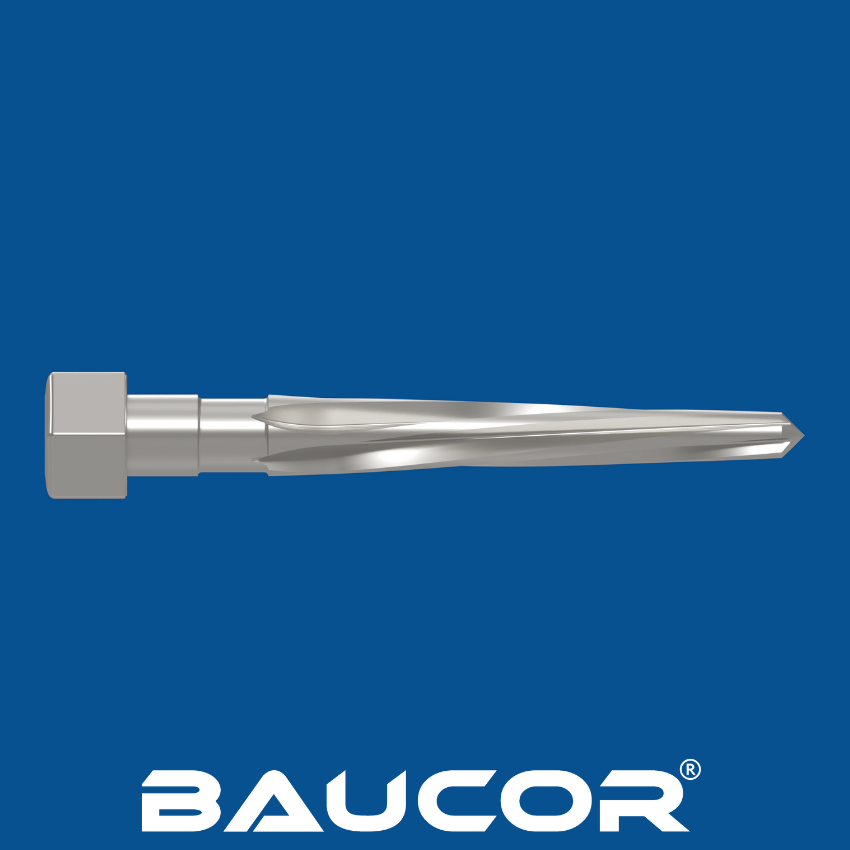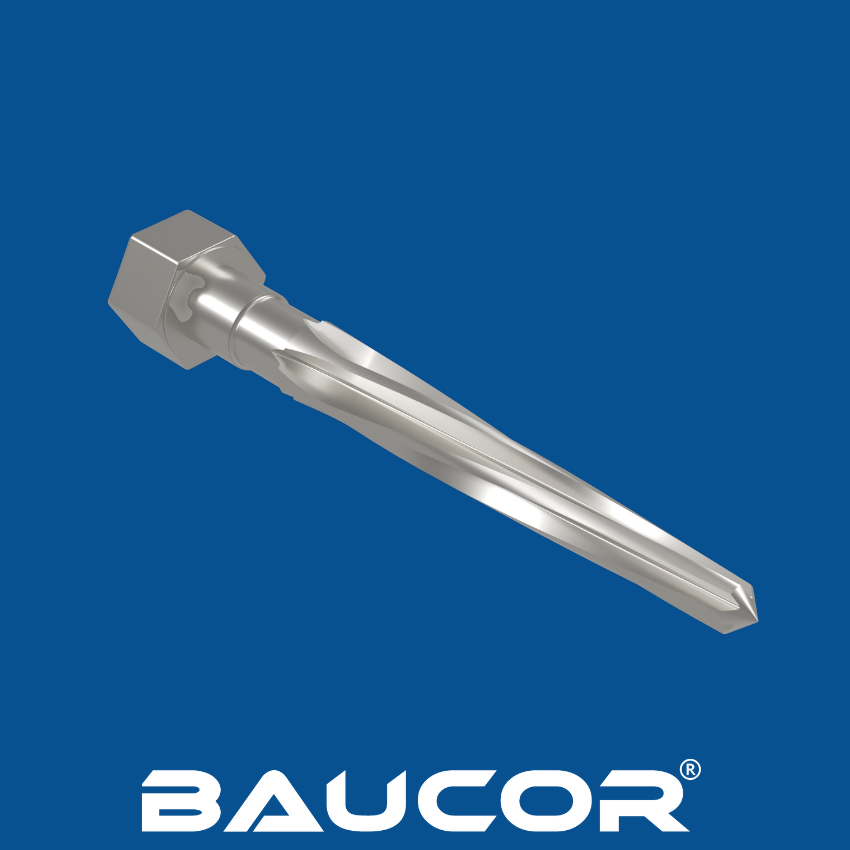BAUCOR REAMERS: WHERE CRAFTSMANSHIP MEETS INNOVATION.
DISCOVER REAMING SOLUTIONS THAT REDEFINE ACCURACY, PERFORMANCE, AND DURABILITY
BAUCOR REAMERS: WHERE CRAFTSMANSHIP MEETS INNOVATION.
DISCOVER REAMING SOLUTIONS THAT REDEFINE ACCURACY, PERFORMANCE, AND DURABILITY
A car reamer is a specialized cutting tool primarily used to enlarge and finish holes in thick metal plates, particularly in applications like truck frames, rail cars, bridges, and industrial equipment. They are designed for heavy-duty use and are capable of cutting through tough materials.
How Car Reamers Work:

The manufacturing of car reamers involves several steps, each designed to ensure the tool's durability, accuracy, and cutting performance:

Baucor, as a leading manufacturer of car reamers, would offer a comprehensive range of sizes to cater to diverse applications in the automotive and industrial sectors. Our car reamer sizes would typically be specified by the diameter of the tool, and they would likely offer both standard and custom sizes.
Standard Sizes: Baucor's standard car reamer sizes would likely cover a wide range, including:
Custom Sizes: In addition to standard sizes, Baucor offers custom car reamer sizes to meet specific customer requirements. This would allow customers to order reamers with non-standard diameters or unique flute designs tailored to their specific applications.
Car reamers are designed for heavy-duty use and are made from materials that can withstand the demands of cutting through tough metals. Here are the most common materials used for car reamers:
1. High-Speed Steel (HSS): This is the most common material for car reamers due to its excellent hardness, wear resistance, and ability to maintain a sharp cutting edge even at high temperatures. HSS reamers are suitable for most general-purpose applications.
2. Cobalt High-Speed Steel (HSS-Co): This is a variation of HSS that contains cobalt, which further enhances its hardness, wear resistance, and heat resistance. HSS-Co reamers are ideal for cutting harder materials and for applications where extended tool life is desired.
3. Carbide: Carbide reamers are made from cemented carbide, a composite material consisting of tungsten carbide particles bonded with a metal binder (usually cobalt). Carbide is extremely hard and wear-resistant, making it suitable for cutting very hard materials and for high-production applications. However, carbide reamers are more brittle than HSS and may chip or break if not used properly.
4. Powdered Metal (PM): Powdered metal reamers are made from a mixture of metal powders that are compacted and sintered to form a solid tool. PM reamers can be formulated to achieve specific properties, such as high hardness and wear resistance. They are often used in high-performance applications.
5. Coating Materials: In addition to the base material, car reamers may be coated with various materials to further enhance their performance. Common coatings include:
Additional Considerations:
The choice of material for a car reamer depends on several factors, including:

Reamers with blades that can be adjusted to slightly vary the hole size.

Long reamers used to accurately ream holes in bridge construction.

Tools that combine a drill and a reamer in one.

Similar to adjustable reamers, these can be expanded slightly to increase the hole size.
Coatings play a crucial role in enhancing the performance and longevity of car reamers. They offer several advantages, including increased hardness, wear resistance, reduced friction, and improved heat dissipation. Here's a list of possible coating options for car reamers:
1. Titanium Nitride (TiN): This is one of the most common and versatile coatings for car reamers. TiN is a hard, wear-resistant coating that reduces friction and heat buildup during cutting. It provides a characteristic gold color and is often used for general-purpose reaming applications.
2. Titanium Carbonitride (TiCN): Similar to TiN, TiCN is a hard, wear-resistant coating that offers excellent protection against abrasive wear and high temperatures. It has a darker color (black or gray) and is often preferred for cutting harder materials.
3. Aluminum Titanium Nitride (AlTiN): This advanced coating is harder and more heat-resistant than TiN or TiCN. It is often used in high-speed machining applications where heat buildup is a concern. AlTiN coatings are typically purple or bronze in color.
4. Zirconium Nitride (ZrN): This coating offers excellent wear resistance and lubricity, making it suitable for cutting a wide range of materials, including stainless steel and titanium. ZrN coatings have a gold color similar to TiN.
5. Diamond-Like Carbon (DLC): DLC coatings are extremely hard and have a low coefficient of friction, making them ideal for applications where wear and friction are critical. They are often used on high-performance reamers.
6. Other Coatings: In addition to the above, there are several other coatings that may be used on car reamers, including:

Reamers designed to be turned by hand, typically with a square drive.

Reamers with left-hand spiral flutes, used to prevent the reamer from pulling itself into the hole.

Reamers designed to be used in a machine, such as a lathe or milling machine.

Reamers with a Morse taper shank for secure holding in a machine spindle.
Car reamers are versatile tools used in various industries where precise hole enlargement and finishing are required. Here's a breakdown of their common applications:
Automotive Industry:
Construction Industry:
Industrial Applications:
Other Applications:
Overall, car reamers are essential tools for ensuring the proper fit and alignment of components in a wide range of applications. Their ability to enlarge and finish holes with precision makes them invaluable in industries that rely on heavy-duty metal fabrication and assembly.
Car reamers find application in a variety of industries where precise hole enlargement and finishing are critical for structural integrity and proper assembly of components. These industries include:
Automotive Industry:
Construction Industry:
Railroad Industry:
Aerospace Industry:
Shipbuilding Industry:
Manufacturing Industry:
Oil and Gas Industry:
Mining Industry:
In summary, car reamers are essential tools in industries that deal with heavy-duty metal fabrication and assembly. Their ability to enlarge and finish holes with precision makes them indispensable for ensuring the structural integrity and proper function of various components in these sectors.
Car reamers are primarily used with machines that can provide the necessary rotational power and stability for cutting through thick metal plates. Here are the main types of machines that use car reamers:
CNC Machines (Computer Numerical Control): For high-precision and high-volume reaming operations, CNC machines are often used. They can be programmed to perform complex reaming operations with consistent accuracy and repeatability.

Reamers with a pilot that guides the tool for accurate alignment.

Reamers with right-hand spiral flutes, used for general purpose reaming.

Reamers with a hollow cylindrical shape, often used with an arbor.

Reamers with spiral-shaped flutes that aid in chip removal.
At Baucor, we are committed to providing our customers with the highest quality car reamers and the support they need to achieve optimal results in their applications. Our team of experienced engineers is dedicated to working closely with our customers to design custom reamers tailored to their specific needs. We take pride in optimizing reamer geometry, flute design, and material selection to ensure the best possible cutting performance and tool life.
Our application engineering team is readily available to offer guidance on best practices for using our car reamers in specific applications. We provide recommendations on cutting parameters, lubrication, and tool maintenance to maximize productivity and extend tool life.
We understand that challenges may arise, and our technical support team is committed to helping customers troubleshoot any issues they encounter while using our reamers. We analyze worn or damaged reamers to identify the root cause and recommend appropriate corrective actions.
To ensure our customers get the most out of our tools, we offer training programs and workshops that educate them on the proper use and maintenance of our reamers. We believe that knowledge is key to achieving consistent and successful results.
At Baucor, we are constantly pushing the boundaries of innovation. Our research and development team is committed to continuously improving our car reamer designs. We invest in developing new materials, coatings, and geometries to enhance cutting performance and tool life, ensuring we remain at the forefront of the industry.
By offering these comprehensive design and engineering support services, Baucor reaffirms its dedication to customer satisfaction and solidifies its position as a trusted partner in the automotive and industrial sectors.

BAUCOR offers custom manufacturing and engineering solutions tailored to your specific needs, across various industries.

BAUCOR's engineers can review your design and provide feedback to improve manufacturability, cost effectiveness, and efficiency.


Designing car reamers requires careful consideration of various factors to ensure optimal performance, durability, and precision. Here are some key design guides to consider:
By following these design guides, manufacturers can create car reamers that deliver optimal performance, precision, and durability for a wide range of applications.